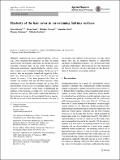Elasticity of the hair cover in air-retaining Salvinia surfaces
Author(s)
Ditsche, Petra; Gorb, Elena; Gorb, Stanislav; Schimmel, Thomas; Barthlott, Wilhelm; Mayser, Matthias J; ... Show more Show less
Download339_2015_Article_9439.pdf (1.190Mb)
PUBLISHER_POLICY
Publisher Policy
Article is made available in accordance with the publisher's policy and may be subject to US copyright law. Please refer to the publisher's site for terms of use.
Terms of use
Metadata
Show full item recordAbstract
Immersed in water superhydrophobic surfaces (e.g., lotus) maintain thin temporary air films. In certain aquatic plants and animals, these films are thicker and more persistent. Floating ferns of the genus Salvinia show elaborated hierarchical superhydrophobic surface structures: a hairy cover of complex trichomes. In the case of S. molesta, they are eggbeater shaped and topped by hydrophilic tips, which pin the air–water interface and prevent rupture of contact. It has been proposed that these trichomes can oscillate with the air–water interface, when turbulences occur and thereby stabilize the air film. The deformability of such arrays of trichomes requires a certain elasticity of the structures. In this study, we determined the stiffness of the trichome coverage of S. molesta and three other Salvinia species. Our results confirm the elasticity of the trichome coverage in all investigated Salvinia species. We did not reveal a clear relationship between the time of air retention and stiffness of the trichome coverage, which means that the air retention function is additionally dependent on different parameters, e.g., the trichome shape and surface free energy. These data are not only interesting for Salvinia biology, but also important for the development of biomimetic air-retaining surfaces.
Date issued
2015-08Department
Massachusetts Institute of Technology. Department of Civil and Environmental EngineeringJournal
Applied Physics A
Publisher
Springer Berlin Heidelberg
Citation
Ditsche, Petra et al. “Elasticity of the Hair Cover in Air-Retaining Salvinia Surfaces.” Applied Physics A 121.2 (2015): 505–511.
Version: Author's final manuscript
ISSN
0947-8396
1432-0630